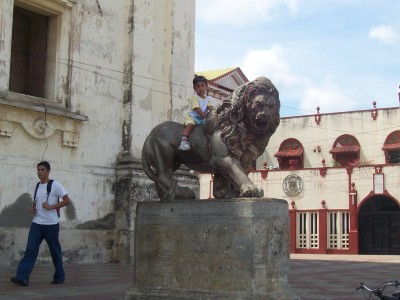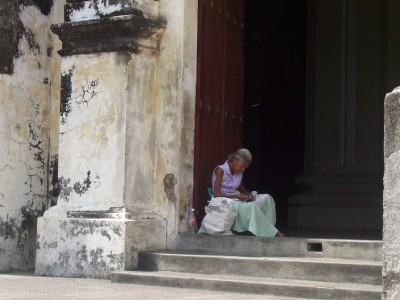Nicaragua... Hermosa (Beautiful)

Border Crossing Los Manos - Nicaragua
We approached the Nicaraguan border post of Los Manos with caution and nervousness (after our episode entering Honduras two months ago), steadfastly resolute that we would not succumb to any corruption... as if.
Sighting the Honduran Aduana (Customs) on the left side, a group of small offices with numerous money changing operations on either side, with the usual gaggle of trabajadores and hanger-oners we parked Miss Piggy.
Grant collected our bundle of 'official' documents and enters the office that appeared the busiest. After several minutes of typically uncomfortable milling around he was courteously escorted by a guard toting a very efficient and imposing semi-automatic rifle to the correct office.
The helpful Aduana official processed our paperwork, with no 'fees' (yee haa), and sends us on our way to Nicaragua, a mere 200 metres along the road to finalise our Honduran exit and commence our Nicaraguan entrance.

Is it a bike or is it a van? Whatever... we want one!
Jules gathered the passports and completed the entry permits while Grant practiced his Spanish with locals keenly interesting on the in's and out's of the bike and our trip.
First window was Honduran Immigration, 110 Lempira ($US6) exit tax for the both of us, a stamp in our passports. Done. Next window, Nicaraguan Immigration, 250 Cordobas ($US14) entrance fee for the both of us, a stamp in our passports. Done. Grant then took the bike documents to the Aduana window and while chooks ran at his feet a lovely young lady typed out a vehicle permit, no fees. Done. Final step, purchase vehicle insurance, a recently introduced law, from the representative on hand, 250 Cordobas ($US14). Done. The whole process took about an hour and was very orderly, efficient and a welcome change.
We rolled the bike to the boom gate, a final check of our documents by the border guard and we were on our way to Estelli, the first big town in Nicaragua.

Lunch Stop
Esteli, 100kms form the border, is a pleasant town with stunning scenery all around and very warm welcoming people, we were looking forward to our stay in Nicaragua. Esteli sustained heavy fighting during the 1978-79 Revolution with scarring evident in many parts of the town. It was a somber reminder of the countries recent turbulent past.
Nicaragua is a relatively small country easily traversed in two days, however, we wanted to see more. Forty six kilometres from Esteli we turned off the Pan-American Highway, to Managua and Costa Rica, to head towards León. The ironly of this choice is that Grant had only just mentioned with surprise and delight at the high quality of the roads in Nicaragua. This was to turn into the roughest paved road we had yet come across in all of the Americas.
We continued on our way at a heady 40kms per hour passing numerous other vehicles crawling along at absurd slowness. It was somewhat reminiscent of riding over a lava field.

Typical transport - better part of the road
Eventually 60 kms passed by, we stopped at a village with no sign post to check our map, with concerns we were on the wrong road. With very few people about and those that were, choosing to avoid us with remarkable efficiency. Two policemen appeard from a building aways up the street and casually wandered across the road towards us.
"Tiene problemas?" (Any problems) the older and obviously higher ranking officer asked.
"No, No" we insisted concerned that we could be targeted for a local tax.
Grant replied to them "Pero nessicito checka mi mappa, por que possible perdido. Esta la carretera a León?" (but need to check the map, because we are possibly lost. Is this the road to León?)
Both officers replied almost simultaneously "Si, si, es no lejos, solo una hora, nada mas" (Yes, yes, its not far, only an hour, no more)
Then the usual questions were asked. Where are you from, where are you going, what size engine is that, how much did it cost? for another half hour we contuinued our Spanish lesson until we we all finally agreed that it was far too hot in the sun. We went on our way, while the two Officers found a shady tree to continue their patrol of the village.
Soon the Los Maribios volcanic mountain chain came into view, and as we rode nearer we realised the road bi-sected the range between what appeared the most active. On the left we could see, off in the distance, Volcán Momotombo rising sharply from the flat plain. To the right stood Volcán Telica and several smaller cones, all appeared to be puffing fumes although as we found out later Telica was the main culprit.
It was quite thrilling to see these peaks of different shapes sizes and colours jutting out of a relatively flat landscape.

Through the Volcanoes
Heavy black clouds hung overhead as we rode into León, the original capital city of Nicaragua, perpetuating the reality that the wet season had commenced in Central America.
León is a colonial city with many low buildings to stand up to the seismic activity of the area. It is not yet over run with tourists and was a nice spot to catch up with Darryn, a fellow Aussie living in Nicaragua and running the Big Foot Hostal. He kindly allowed Miss Piggy to be housed in the communal kitchen.

Piggy in the Kitchen
For several days we wandered about viewing the local attractions including the Basillica de la Asunción that is guarded by statues of lions said to come alive at midnight.

Lion of Leòn
Grant, keen to visit one of the active volcanos in the area, signed up for a tour of the Cerro Negro crater. For four hours he hiked over the inhospitable and unforgiving terrain descending into the crater passing exposed sulphur veins, the fumes taking your breath and making the ascent demanding.

Cerro Negro Volcano
At times climbing the loose scorria was three steps forward two step back. On the steep slopes you could actually dig into the deep volcanic sand and run without any forward motion. It became quite tiring, however the views were wonderful and worth the effort.

Basilica - Leòn
